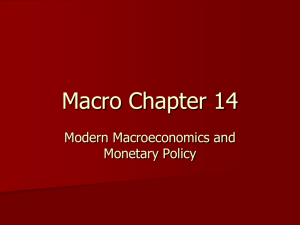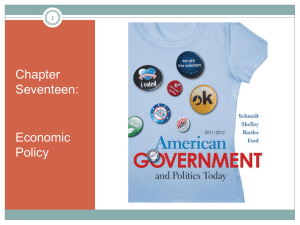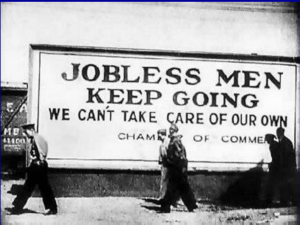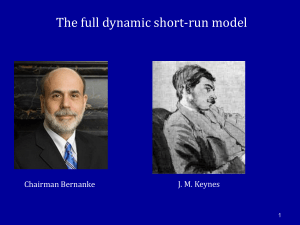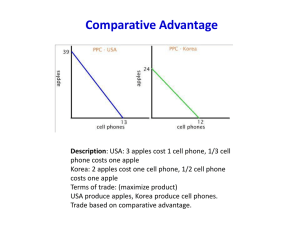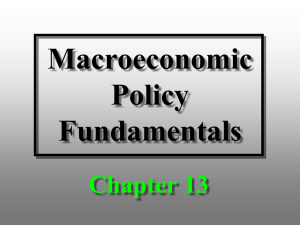chapter 18
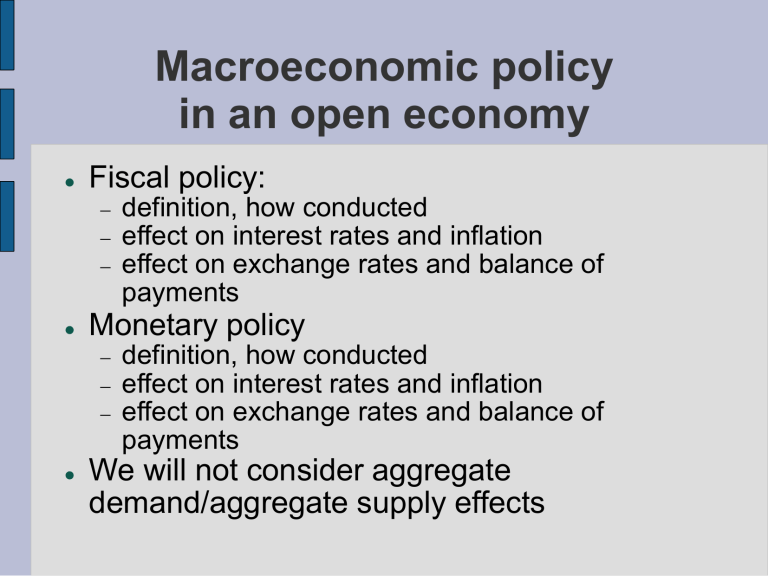
Macroeconomic policy in an open economy
Fiscal policy:
definition, how conducted effect on interest rates and inflation effect on exchange rates and balance of payments
Monetary policy
definition, how conducted effect on interest rates and inflation effect on exchange rates and balance of payments
We will not consider aggregate demand/aggregate supply effects
Fiscal policy
Keynes: the government should
deliberately incur deficits when the economy is in
recession, so as to stimulate demand incur surpluses when the economy is booming, so as to dampen demand
His deficit prescription was very popular with politicians, business people, taxpayers – a free lunch!
Surplus prescription largely forgotten
Effects of fiscal stimulus on loanable funds market
Increased spending must necessarily be financed by borrowing
If it were financed by taxation, there would be no stimulative effect, just a wealth transfer from taxpayers to politicians
Causes outward shift in the demand curve for loanable funds
Raises interest rates, other things equal
Crowds out marginal private borrowers
The supply of loanable funds is not perfectly inelastic as Fig. 18.1 suggests: higher interest rates encourage saving
Deficits do not cause inflation
Deficit spending does not in itself increase the money supply, so there is no money inflation
There could be a minor price deflation as people are induced to save more by higher interest rates, meaning they demand fewer consumption goods
Deficits indirectly lead to price inflation when central banks soak up some of the new bond issues using newly created money
Effects of expansionary fiscal policy on exchange rates
Higher interest rates attract capital from abroad, e.g. UK investors who must change
£ into $
In $/£ forex market, the supply of £ rises and the $/£ XR drops
Also US investors are less inclined to invest in UK, therefore demand for UK£ drops, and this further suppresses the $/£ XR
Lower $/£ XR due to fiscal stimulus
A lower $/£ XR (appreciated $) is (in the short run)
bad for US export industries since exports cost more for UK buyers (in terms of £) good for US consumers since UK imports cost
less (in terms of $) good for UK producers who face reduced competition from US producers bad for UK consumers for whom imports from
US cost more
Public choice theory says the US producers have a louder voice & will complain to their politicians: “We are bearing an unfair burden!”
Summary of effects of fiscal policy on international trade
Expansionary fiscal policy
Loanable funds market
Increased demand (to cover deficit) raises interest rate
Higher interest rate boosts capital inflow, discourages outflow
Capital account improves, current account worsens
Increased supply of foreign currency to buy US securities suppresses XR
Reduced demand for foreign currency to acquire foreign securities further suppresses
For our example, $/£ falls, meaning the US$ appreciates)
Inflation
No direct effect
Contractionary fiscal policy
Everything is reversed
Monetary policy
Central banks now monopolize the business of supplying money
Our money is purely fiat money meaning that it is not even indirectly related to any commodity (gold or silver)
The Fed engages in discretionary monetary policy (as distinguished from a rule-based policy)
The Fed chairman, Alan Greenspan, was thought to be a wizard until the 2007 collapse
The Fed expands the money supply when it believes this necessary to stimulate the economy
Expansionary Monetary Policy
The Fed expands the money supply (money inflation) by buying Treasury securities from
New York bond dealers using newly created money (“open market operations”)
Fed expansionary policy constitutes an increase in the supply of loanable funds
(supply curve should not be inelastic as in
Fig. 18.7)
Drives down interest rate
Encourages business borrowing which is supposed to revive the economy
Summary of effects of monetary policy on international trade
Expansionary monetary policy (cont’d)
Inflation
Money inflation results in price inflation (falling PPM)
Price inflation makes US goods less attractive to foreigners, and foreign goods more attractive to US people
Supply of foreign currency drops, demand rises
XR rises, US$ depreciates loanable funds market
New money created by the Fed enters the bond market, supply of loanable funds rises
Interest rate falls
Foreigners less interested in US securities, US
people more interested in foreign securities
Demand for
Summary of effects of monetary policy on international trade
Expansionary monetary policy (cont’d)
Inflation
Increased supply of loanable funds (newly created
Fed $) suppresses interest rates
Lower interest rate means some capital goes to foreign countries
Capital account worsens, current account improves
Reduced supply of foreign currency from foreigners wanting US capital assets, and increased demand for foreign currency by US people, raises XR of foreign currency (e.g. $/£, falls, meaning the US$ depreciates)
Inflation
No direct effect
Contractionary monetary policy: everything is reversed
How all of this complication could vanish
Replace central banking with free banking where private banks issue money in response to user demand.
Government monetary policy ceases to exist
Try to maintain a balanced budget at all times
Government fiscal policy ceases to exist
As more countries adopt free banking, market forces would push money issuers toward a common standard
XR issues would cease to exist
Domestic stimulus or currency war?
Expansionary monetary policy as we have seen depreciates a country’s currency
Open question: were recent expansionary monetary actions (Japan, U.S.) intended to stimulate the domestic economy generally or were they specifically trying to boost export industries, thus inviting retaliation?
The J Curve
Devaluation of a country’s currency leads to expansion of exports and an increase in its current account balance (increased surplus or decreased deficit)
The short run effect may be in the opposite direction. Why?
Exporters may have long-term commitments to
sell at a particular price. Those terms may be renegotiated later, and increased production comes on line only later
But import prices rise immediately
Net short-term effect: worsened current account


